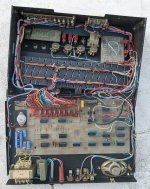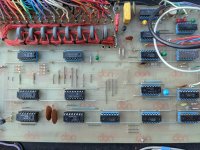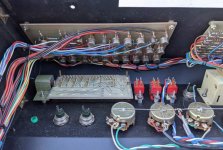Prepare for a long read, or just scroll to the picture and take some guesses, if you prefer. I've tried to dump all the information I have on these things below in case someone else has one or needs one and doesn't know, this will be searchable text for them.
I have had these cards in my possession for a couple years now but never really figured out anything about them. I have duplicates of all of these - A long time ago, my local metal recycling facility received several Konica Minolta printers and print servers from the mid to late 90s. I actually did take two machines home, the most complete examples which are labelled "Konica IP-301" and "IP-304" respectively. The 301 is a baby-AT Pentium machine and the 304 is an ATX socket 370(?). Both have their hard drives but I've never actually tried to boot either.
--------------------------------------------------------------------------------------
Two of these cards did not come out of the Konica equipment, center left which came out of (I think) some type of IBM RISC thing (RS/6000 maybe? It was a long time ago. All black non-standard case, pretty large and heavy, two displays including the following were on the case, a SCSI tape drive and CD-ROM drive were installed in the other bays, and a softpower button) and was running an LCD that was mounted in a 5.25" bay, which I have the corresponding LCD somewhere, along with several other examples of this card which did not have LCDs attached. The bottom right came out of some other machine, I have no clue what it does at all. It has two DB-15 connectors which are labelled "A1-8" and "A9-16". It has a piezoelectric speaker on board, and the only connectors with a plaintext label on the entire board read "PC-RESET" and "RESET_SW" leading me to believe they intended you to have your reset button hooked up to it. It's actually two boards sandwiched together, the second board on the back does not connect to anything but the first board, has no face plate at all, and has 8 BGA components all with individual small heat sinks and an SDRAM chip next to each of them. There is a socketed component on the front with a label which reads "LL32 V2.0".
My guess is that the weird double layer DB-15 card was some type of automated data acquisition setup. No idea what for, no clues about software or drivers, I've never been brave enough to actually stick it into a PC and see what happens. It could also have been some fancy coprocessor, I think.
The other not-a-Konica card I think is meant for some type of capture device? I have no idea what kind of connector it uses, but it looks like a shorter and fatter SCSI HDI connector to me. The internal LCD connected to the large internal grabby connector along the top. The other two had nothing connected, if I remember. The board says "94V0 ELEC1G-12B" along the top with what looks like a date code of 14th week of 2000. On the right edge reads "IX UIB PCI Card P/N 10021433 ELECTRONICS FOR IMAGING"
Starting from the top left of the remaining Konica cards, it has a similar but different pin count HDI connector from before, with a single row Molex connector at the top. The only obvious markings on the card are ">EP-GF70<" and "13MP-904" There is a socketed PLCC chip which is labelled "KONICA PS-332 13MX89010" Two of the large chips are actually Konica branded. One is an IDT chip and the other looks like a Hitachi SH-2! There are two RAM chips which I imagine are associated with the SH-2. There are two LEDs on the top left which are hidden behind the plate, I.E. they are only visible inside the computer. The only other distinguishing feature is space for a large connector that is unpopulated on this board. Other than component positions, there is no text at all on the back, and it is all passive components. I think this may be an image processing card of some type as well? Possibly image capture or hardware compression?
The next card to the right, the absolutely massive full length card is the most interesting to me. Of course, it's size makes it interesting, but the components seem interesting too. The large Intel chip at the bottom center is a PCI to PCI bridge. Of course, there is also a Xilinx Spartan FPGA marked XCS20XL. There appears to be some type of flash memory between the Spartan and the bridge. On the edge of the card is a huge multipin connector, the same general shape as the others described, this one the largest. There are 4 large BGA components with large passive heat sinks ,each appears to be associated with 2 memory chips of some type. Other than component positions, there is no text on the back side. All of the back side are passive components. Two components, marked "STEWARD CM4545" appear to be chokes next to the PCI-X connector. The only discernible text on this card reads "EFI BEARS PN45005212". There is a label on a chip which reads "45005569A D2E0 V1.0 04/28/00PP" There is a barcode label along the bottom edge of the card with the same part number, a date of "06/00" and the text "PCBA,PLUG-IN,VIDEO,BASE" This card could be literally anything. I have no idea what it does. It seems very obvious that it is a powerful hardware coprocessor of some kind, but for what I am not certain. A long time ago, I plugged this card into a Dell PowerEdge 2600, one of the only machines I own which has PCI-X slots, and Windows XP did see the PCI to PCI bridge but nothing else, even after a few restarts and searching for hardware. I would LOVE to know what this board does, it's such a cool looking thing that I actually spent some time all those years ago to properly clean it and had it propped up above my desk for years. I'd like to put a label beneath it saying what it is someday!
The next Konica card, below the last, is also a massive full length card, this one regular PCI. It has exactly the same short outward facing connector as the other weirdo, and what looks to be an identical locking connector. It is labelled for 26 pins. The only text on the card reads "KONICA TECHNOLOGY ASSY. 01-0490 REV 2" and a serial number on a sticker. There is a socketed PLCC chip which has a label reading "IP 302 P26-1.0" There are several chips labeled "IP302P" with various numbers beneath them. The 3 large chips are an AMCC part labelled "PCI MATCHMAKER", a Motorola 68331CPV16 which appears to be a microcontroller from the 90s, and a part whose brand I cannot immediately identify. It looks like it says "sdt 7024 S35J X9831P" There are positions along the top for two unpopulated 80 pin high density connectors and a low density 10 pin connector. Given the microcontroller, this is possibly some type of automation controller?
The small card in the bottom left is also from a Konica machine. It has a single outward DB-25 connector, is standard PCI, has NO components or text at all on the back, has a single major component labeled "Konica KPC01", has an unpopulated position for a 10 pin connector along the top, and is marked with just two things: ">EP-GF70< 13MP87050" and "13MP-905" with a 0 sharpied in afterwards. I have plugged this card in, but it did not show up in Windows XP. I think this card is damaged, possibly by water, as there is evidence of rust on the face plate and calcium buildup on one edge of the card. This card could be a lot of things, most likely of which are a parallel printer port or SCSI-1, but if that were the case, why would Konica go out of their way to obfuscate such a device? I think this card probably served some other purpose.
The final card is in the bottom center. It is also PCI-X and has a similar very large HDI connector on one edge. There is no text on the backside of the card other than component positions and all components are passive. The card is composted of two boards, the top board has the large HDI connector and face plate, while the bottom board has the PCI-X edge connector. The daughterboard has a single major component visible, a Xilinx part labelled "XQ95108 TM". There is an unpopulated 10 pin connector labelled JTAG. The only text on the daughtercard reads "MINOLTA PC PN 10021350". There is a long barcode sticker on the edge with a date code of 11/99, the same part number, and the text "PCBA,PERSONALITY,MX". There appear to only be passive components on it's underside, and it has two large connectors arranged horizontally between the plastic standoff pegs which attach it to the board below. The board below has two large BGA components, one with a heat sink which is partially visible in the photo, the other which is totally obscured by the daughtercard. Between them is a small QFP component with a vinyl label that I cannot read at such an extreme angle. There are two chips which appear to be memory on the right edge of the card, which read "GAL VANTECH GVT7164D36T-5". The only text on the card similarly reads along the top as "VXP VIDEO CARD PN45002816" and there is a long barcode sticker on the edge with a date code of 12/99, the same part number, and the text "ASM,VIDEO CARD,MINOLTA,Z" I am aware that Minolta is part of Konica's brand name in some instances. The face plate of the card shows signs of corrosion and calcium buildup, possibly from water damage. I have never tried to attach this card to a computer.








